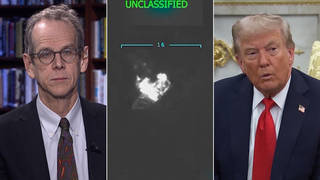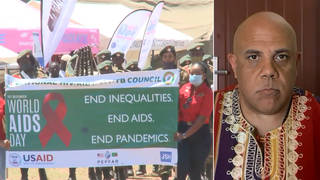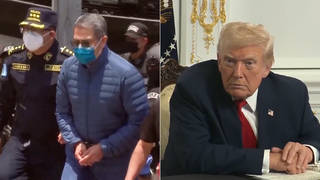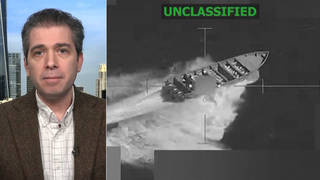
Guests
- James Steele and Donald Barlettcontributing editors at Vanity Fair. Barlett and Steele have won virtually every major national journalism award, including two Pulitzer Prizes and two National Magazine Awards. Their latest article for Vanity Fair is called “Good Billions After Bad.”
- Donald Barlettcontributing editor at Vanity Fair. Barlett and his reporting partner James Steele have won virtually every major national journalism award, including two Pulitzer Prizes and two National Magazine Awards. Their latest article for Vanity Fair is called “Good Billions After Bad.”
It’s been exactly one year since the onset of the financial crisis and the passage of the Bush administration’s $700 billion bailout of Wall Street. But what were the factors in deciding who received bailout funds? And what happened to all the money? The answer to those two simple questions is: We don’t know. In a new article in Vanity Fair, the Pulitzer Prize-winning investigative team Donald Barlett and James Steele try to find an answer. The problem is, they write, “once the money left the building, the government lost all track of it.” [includes rush transcript]
Transcript
JUAN GONZALEZ: Well, it’s been exactly one year since the onset of the financial crisis and the passage of the Bush administration’s $700 billion bailout of Wall Street. The bailout marked the single largest financial intervention by the Treasury into the banking system in American history.
But what were the factors in deciding who received bailout funds? And what happened to all that money? The answer to those two simple questions is: we don’t know.
In a new article in Vanity Fair, the Pulitzer Prize-winning investigative team Donald Barlett and James Steele try to find an answer. Poring over bank records and Securities and Exchange Commission filings, Barlett and Steele recreate what happened in late 2008, when the Bush Treasury Department, led by former Goldman Sachs CEO Henry Paulson, sought to prevent a complete Wall Street meltdown by pouring billions into the banking system.
AMY GOODMAN: The problem is, they write, “once the money left the building, the government lost all track of it…It was hard to escape the feeling that the real strategy was less than scientific — amounting to a hope that if a massive pile of money was simply thrown at the economy, some of it would surely do something useful.”
Well, Don Barlett and Jim Steele have won virtually every major national journalism award, including two Pulitzer Prizes, two National Magazine Awards. Their latest article in Vanity Fair is called “Good Billions After Bad.” They’re joining us from their home city of Philadelphia.
Jim and Don, welcome to Democracy Now! Jim, let’s begin with you. Tell us how you tried to track this money.
JAMES STEELE: Well, Amy, it was very difficult in the beginning, because even within Treasury, Treasury had no internal controls at the beginning of this whole process. They basically were just throwing the money out. And the whole process about deciding who got it and so forth was one of the most complex, murky processes we have ever encountered.
The beginning banks, the first nine, the big banks, they all got their money one day after a meeting with Henry Paulson, in which he told them, “You’re taking this money.” But after that, the process was much more convoluted. And some banks lobbied for the money. Others banks didn’t lobby for the money but were told they were taking it. It all — what we basically concluded early on, that there was really no plan to this at all. While Treasury said that the purpose was to get credit flowing back into the system, the fact of the matter is, the way they went about this made no sense at all.
JUAN GONZALEZ: Well, what about that big meeting that you talk about — I think it was October 12th — the nine big banks? Eight of those banks, as you reported, ended up getting two-thirds of all of the money, 67 percent. How did that meeting come about, and who was there?
JAMES STEELE: Paulson actually called that meeting. He called the heads of those banks the night before and said, “I want you here tomorrow in Washington.” He was very vague as to what the purpose of the meeting was. But once they got there, he told them, “You are taking money. We are going to buy stock in your banks. And we need to get this economy going again.” Some bankers objected, saying by accepting this money it would look like they were weak. Others simply said they didn’t need it.
The fact of the matter is, one of the things we concluded very early on in this whole process is that while Treasury was trying to create the image that there was widespread weakness in these banks — and then there was a credit freeze, there’s no doubt about that — the way they went about this, just throwing the money out there in hopes that that would get the economy going, is not really what this was all about. There were just a handful of institutions that were terribly weakened. AIG the insurer, Bank of America, Citigroup, those three were clearly in very weakened form. So, many of the other big banks were not. And the best example that they didn’t need this money in the beginning was that many of them, within just a very few months, paid everything back.
AMY GOODMAN: Don Barlett, this meeting of the big nine, with Vikram Pandit of Citigroup, Jamie Dimon of JPMorgan Chase, Kenneth Lewis of Bank of America, Richard Kovacevich of Wells Fargo, John Thain of Merrill Lynch, John Mack of Morgan Stanley, Lloyd Blankfein, who succeeded Paulson as head of Goldman Sachs, Robert Kelly of the Bank of New York Mellon and Ronald Logue of State Street Bank, went to the secretary’s conference room. It was even difficult to find this information out. But what did he lay out for them there? And how does Paulson, who was former head of one of these banks, fit into it, as well?
DONALD BARLETT: Well, reduced to its simplest terms, he laid in front of them, each of them, a sheet of paper and saying, “Write on this the amount of money you’re going to take, and you are going to take it. Otherwise,” the implication was, “regulators will be looking at you and finding something wrong there. This is one of those areas in which you have no choice. By the end of the day, you will sign that you’re taking this amount of money. You know, call your boards, do whatever you need to do, but you will take the money.”
JAMES STEELE: Amy, this is one of the most astonishing things to us as part of this whole investigation. Here you have these people signing by hand their names, the date of the meeting, and filling in with a felt-tip pen how much money they wanted: $25 billion in one case, $15 billion in another, $10 billion. A one-page piece of paper. Wouldn’t we all like that the next time we take out a mortgage or a car loan or anything like that?
JUAN GONZALEZ: Well, you also mentioned that when the government got to then dispensing money to hundreds of other banks around the country, the same simple application process: the name of the bank, the number of shares, and how much money they wanted. It’s astounding that this was a level of scrutiny that was given to all of these banks as they took the money.
DONALD BARLETT: I think, you know, Jim has made the point, and it can’t be made too strongly, that in — you’re intuiting it, but basically this was a bailout aimed at two or three Wall Street institutions, and not to make it look like that, Paulson brings everybody in, or as many banks as he can get, so that it looks like everybody needs this help equally. And they absolutely did not.
JAMES STEELE: And the best — the second best illustration why this was the case, this bailout was supposedly to give money to these banks to build up their balance sheets, their reserves, so that they could then start loaning money again. But when we looked at many of these banks, we found out some of these banks didn’t start loaning money; they bought other banks. Others actually jacked up their credit card rates, and thereby making credit and the flow of credit much harder for customers, some of whom they’d had for decades. So the basic purposes of this money, which was to free up credit, allegedly, did not come about.
DONALD BARLETT: And the other aspect of this is, the one non-bank beneficiary, AIG, the giant global insurer, got its money and then turned around and paid off a loan from the Federal Reserve. And that money was distributed to foreign banks. So you had this bizarre situation in which France’s Société Générale gets almost $12 billion, following having lost nearly that much money in a series of rogue trading deals. Deutsche Bank in Germany gets eight or nine billion dollars. It had lost billions in bad bets. So here’s the American taxpayer actually bailing out these foreign banks, which had their own problems, which were a very different set of problems than subprime mortgages.
JAMES STEELE: You know, they’re doing this at the same time homeowners throughout the country are having their houses foreclosed, and there’s no relief for them.
DONALD BARLETT: And, you know, you could really — the average taxpayer in this country — that’s people making less than $75,000 — should take a bow, because every dollar in income tax they pay for four years went to this bailout.
JUAN GONZALEZ: Well, you could make an argument that, given the financial crisis, they had to get some of this aid out as quickly as possible. But then, the issue then of tracing where the money went, what was — as you found out, what was the government’s fiduciary responsibility in terms of finding out where this money went?
DONALD BARLETT: Well, what they did was they gave you — for example, AIG got x billion, Goldman Sachs. They identified how much money went to those institutions, but the real brilliant stroke of genius behind this plan was it concealed forever the actual transactions which were being bailed out.
JAMES STEELE: There was not even in the Treasury, in the beginning, the normal processes of accountability. The Government Accountability Office looked at this a couple months into the bailout, and you can just feel in their report a kind of astonishment that there were no internal controls, that there was no office, no desk in there to see, once the check went out, once the money was wired to a bank, what that money did. Did that money — did that bank make credit available to its customers? Did that bank buy other banks? What did the bank do with that money? And what you see over and over again in those early months, they weren’t even asking that question. And they, in fact, refused to ask that question of almost all the banks.
DONALD BARLETT: And you can make a strong argument, again by kind of an inverse deduction, the outcome would have been exactly the same had there been no bailout and bankruptcy court had been allowed to take its course.
JUAN GONZALEZ: And you also note that one of the recipients of federal aid was hired, then, by the federal government to actually give out the money —
JAMES STEELE: Yes.
JUAN GONZALEZ: — of Mellon Bank, to all of the other — to all of the other banks, as well.
JAMES STEELE: Absolutely. And there were — that was one of the potential conflicts of interest that you saw in this whole process. Mellon Bank was one of the big nine at that meeting that Paulson called together. And then they were one of the first ones to receive a contract to oversee — to do some accountability on the money. But you saw that over and over and over again. Again, the Government Accountability Office was very critical of the process within Treasury, saying most of the arrangements for very high-risk contracts for which the government had almost no ability to really track whether the goals were being met or not.
AMY GOODMAN: Well, we have to leave it there. We want to thank you both very much for being with us, James Steele and Donald Barlett, the Pulitzer Prize award-winning team. Their latest piece appears in Vanity Fair. It’s called “Good Billions After Bad.” As the Bush administration waned, the Treasury shoveled more than a quarter of a trillion dollars into TARP funds into the financial system without restrictions, accountability, or even common sense. That does it for our show. We’ll link to the article.












Media Options